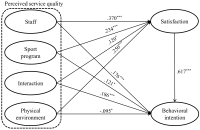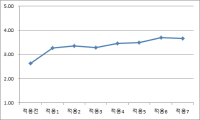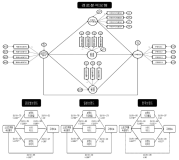PURPOSE Taekwon gymnastics is expected to be a program that can overcome the management difficulties currently faced by Taekwondo gyms and contribute to the expansion of Taekwondo base. Therefore, this study aimed to examine the relationship among organizational identification, flow experience, intention to continue participation, and recommendation intention of Taekwon gymnastics participants. METHODS In this study, data was collected from 313 teenagers participating in Taekwon gymnastics at Taekwondo gyms in the metropolitan area from September 10 to 24, 2021. A total of 267 questionnaires were selected as the final sample, and data analysis was conducted using SPSS 23.0 and AMOS 23.0. RESULTS Organizational identification had a significant effect on flow experience, challenge only had a positive effect on intention to continue participation, flow experience did not significantly affect recommendation intention, and intention to continue participation had a significant effect on recommendation intention. CONCLUSIONS The results of this study confirmed that organizational identification can contribute to improving inner pleasure and self-esteem, and it is necessary to examine the role of factors that can mediate the relationship between flow experience and behavioral intention in the future. Furthermore, managers of Taekwondo gyms should hold various events that can inspire teenagers’ sense of challenge to encourage intention to continue participation.
PURPOSE The purpose of this study is to examine the goalkeeper’s area of defense and how the range varies depending on the relative position of the goal, goalkeeper, and ball in a 9-meter jump shot during handball matches. METHODS Data was collected from seven qualifying divisions in mens handball from the 99th National Sports Festival in Korea. A total of 231, 9-meter jump shots were analyzed with the goalkeeper‘s area of defense measured from the point the ball left the shooter’s hand and calculated based on the relative position of the goal, goalkeeper, and ball. Video analysis was conducted using the Kwon3D 3.01 program and three-dimensional coordinates calculated using the DLT method. RESULTS First, dimension of handball goals measure 3m wide and 2m high, however, results show that goalkeeper’s actual area of defense was narrower than the width of the goal posts, while vertically, area exceeded the height of the cross bar. Second, if the goalkeeper defended the striker’s shot from the side rather than from the front, the goalkeeper’s defense range was higher for the opposite side of the goal post than the near side of the goal post. CONCLUSIONS Key factors influencing goalkeeper’s area of defense include height of shot and position of goalkeeper. Results also indicate that vertical movements are more important than horizontal movements for goalkeepers in handball thus such implementation in training may lead to performance enhancement.
Purpose Student-athletes in Korea are confronted with career development in both academics and sport. This paradigm change in sport policy aims at guarantee of student-athletes' learning rights and successful career transition after sport. But dual career development can be a difficult task for student-athletes, if there is a lack of social support. The purpose of this study was to provide updated information regarding the burnout-in-sport literature and suggest directions for future research in sport psychology. Methods This study is based on reviewing the literature. In order to improve the validity of discussion, the author focused on the findings of the published research articles targeting student-athletes. The outcomes were examined and discussed based on models and measurement tools of athletes’ burnout. Results First, longitudinal study is needed to understand causalities in sport burnout. Second, it is necessary to develop korean sport burnout scale reflecting our social and cultural contexts. To do this, qualitative research should be preceded to provide in-depth understanding on burnout phenomenon of student-athletes. Third, the cut-off values which can allow the separation between clinical and nonclinical athletes should be developed. Fourth, due to dual career development as a new sport environment, burnout research has to pay attention both psychological variables in person and environmental variables. Conclusions Since the 1990s burnout research in sport psychology has been increased in its quantity as one of the remarkable topics in Korea. Based on the comprehensive and systematic review of the literature, directions for future research are suggested.
Purpose The purpose of this study was to identify the effect of a power-specific weight training program in order to improve the muscle strength of Korean national team’s freestyle wrestlers. Methods Participants were 13 male athletes in the national freestyle wrestling team. The period of the program was 6 weeks. Muscle strength, muscular endurance, muscle power, flexibility, agility, cardiorespiratory endurance, anaerobic power and isokinetic muscle function were measured. Data were analyzed using IBM SPSS Statistics ver. 23.0 (IBM Co., Armonk, NY, USA). Paired t-test was conducted for comparison between pre-test and post-test score. Results There were significant difference and tendency in the leg isokinetic power and trunk isokinetic flexion strength. However, there was no significant difference in muscle strength, muscular endurance, muscle power, flexibility, agility and cardiorespiratory endurance. Conclusion The 6-week program focusing on the power-specific weight training indicated a significant difference not in every variable but in isokinetic muscle power, speed power and core strength. It is suggested that the training program was applied to the athletes less continuously and not in the long term because of frequent international games abroad and the need for losing weight. Consequently, a year-long training program with personalized methods should be developed to bring about more significant outcomes.
Purpose The purpose of this study is to compare the maximal strength, isokinetic muscle function and anaerobic capacity according to the position of college and professional rugby players. Methods Subjects for this study were 54 athletes and randomly divided into 4 groups: the forwards group in college rugby players (FCRP, n = 10), backs group in college rugby players (BCRP, n = 16), forwards group in professional rugby players (FPRP, n = 16), and backs group in professional rugby players (BPRP, n = 12). Physical fitness was consisted of squat, bench press, bilateral grip strength. Isokinetic knee and trunk muscle functions were measured by Humac Norm device, and anaerobic pedaling power was analyzed by Wingate test. Significant differences between groups were determined with one-way repeated ANOVA. Results As the result of this study, there was no statistically significant difference between the absolute and relative values of the squat and bilateral grip strengths, but bench press was significantly higher in FPRP and BPRP compared to other groups. Isokinetic knee and trunk extensor and flexor muscle strength showed stronger in FPRP and BPRP than those in FCRP and BCRP. In addition, the anaerobic pedaling power was also the highest in FPRP and BPRP. Conclusions Our findings suggest important information that the college rugby players and forwards in professional rugby team should be given scientific training to improve their maximum strength, isokinetic strength and anaerobic power.

Purpose This study aimed to investigate the impact of perceived service quality on satisfaction, and behavioral intention in migrant members of German sport clubs. Methods The questionnaire was structured in four sections: perceived service quality (four dimensions and 12 items), satisfaction (two items), and behavioral intention (two items). With data from 438 members of 33 sport clubs in western Germany, SPSS 23.0 and AMOS 23.0 were utilized to conduct factor analysis, reliability, validity, and structural equation modeling analysis. Results The results of this study indicated that (1) staff, sport program, interaction, and physical environment in perceived service quality had a significantly influence on satisfaction, (2) staff, sport program, and interaction significantly affected behavioral intention, and (3) satisfaction was found to have significantly impact on behavioral intention. Conclusions The delivery of high-quality services can promote satisfaction, which in turn lead to behavioral intention. The empirical results suggest that the practitioners and sport club mangers should understand the importance of perceived service quality for the retention of members in sport clubs.


[Purpose] The present study attempted to verify the effectiveness of an early childhood physical health improvement program (subsequently in the present study, KICCE Early Childhood Health Improvement Program) developed in Korea by modifying and improving the Mission-X: Train Like an Astronaut program developed by NASA to be suitable for children of ages 4 and 5. [Methods] The subjects in the study were 679 children at 7 facilities in Seongnam city, Osan city, and Yongin city, of which 4 were daycares and 3 were kindergartens. The participant group consisted of 339 children, and the control group consisted of 340 children. The program consisted of total 24 activities 3 times a week over 8 weeks, of which 8 activities were related to nutrition and 16 activities were related to physical activity, and in the 9th and 10th weeks, the 16 physical activities were reconfigured and performed 3 times a week. Physical parameters and related fitness parameters were measured before and after the program, and an ANCOVA analysis was performed in which descriptive statistics and scores before the program were the covariate variables. [Results] The results show that first, growth statuses of participant children were in the upper middle section of the distribution, and second, of the 6 fitness developments, flexibility, balance, and quickness were improved, and in most areas, boys and below-normal-BMI group showed beneficial effects. [Conclusion] Thus, KICCE Early Childhood Health Improvement Program is conclusively proven to be effective for early-childhood physical development.

Purpose This study was to investigate the systematic application of the life skills program and its effects in a sport setting. Methods Participants were 14 college students(8 males and 6 females) majoring in Taekwondo. Survey tools were utilized to measure items of life skills and journals. Data analyses were conducted by using Excel program and inductive content analysis. Results First, life skills in this study consisted of goal setting, self-talk, imagery, cognitive restructuring. Life skills program has undergone a procedure, such as the introduction, training, development, application, and evaluation. Second, the average scores of life skill variables have been changed according to measured points. Specifically, the average scores of goal setting and self-talk were highly increased over time and the average score of imagery indicated gradual rising line. The average score of negative thought was slightly reduced over time. Third, regarding effects of this program, participants’ responses were categorized into six components; performance enhancement, positive thoughts, chances of change, goal setting, struggling efforts, and motivation formation. Further, participants stated this program was a great opportunity to develop these components. Conclusion The application of life skills program in sport settings will contribute to participants’ life span developmental change in cognitions, emotions, and behavior.





Purpose The purpose of this study was to examine students’ perceptions of girls’ participation in physical education(PE) in elementary schools and examine the impacts of a girl-friendly integrated program on children’s participation in PE classes. Methods The participants were 10 fifth graders (5 girls and 5 boys) and their teacher in an elementary school. Data which were collected from in-depth interviews with students, students’ journal entries, field observation, and teacher’s reflective journal entries were analyzed inductively. Results Findings revealed that boys perceived girls’ participation as passive, possessing a low level of skills, and staying at the peripheral position. Meanwhile girls expressed their desire to demonstrate their strengths in PE classes and were afraid of boys’ criticism regarding their lack of skills. There were also misconceptions and misunderstanding on girls’ PE participation between boys and girls. In order to resolve these issues, a girls-friendly integrative program was designed. based on the four guiding principles drawn from students’ perception: (1) from ignorance to interest, (2) from misunderstanding to understanding, (3) from sport skills to sport values, and (4) from competition to cooperation. The program integrated boys and girls for promoting active interaction and also integrated competence, knowledge, and dispositions to accommodate students’ various ways of PE participation. Findings revealed that the program had: (1) diversified students’ perceptions of PE participation, (2) promoted students’ diverse and active participation, and (3) established classroom atmosphere which emphasized positive values.



The purpose of this study was to examine competitiveness of sport product companies by brand origin in the Korean market by analyzing attribute evaluation of sport products, brand equity, and purchase intention and their causal relationship. Competitive sport brands were selected in global, Japanese, and Korean brands by a pilot survey. Then, this study selected a population participating in sports for all, elite sports, professional sports, and leisure sports and 498 effective questionnaires were secured. As a result, Korean consumers for sport products evaluated global sport brands in the highest level, Japanese sport brands in the moderate level, and Korean sport brands in the lowest level in the evaluation of attribute evaluation of sport products, brand equity, and purchase intention. Moreover, the evaluation of participating types in sports for all, elite sports, professional sports, and leisure sports showed the same result in the order of global, Japanese, and Korean sport brands. Global sport brands had a sequential causal relationship from attribute evaluation of sport products to brand equity and purchase intention and formed a consumption behavior model that attribute evaluation of sport products led to purchase intention. On the other hand, while Korean sport brands had a sequential causal relationship from attribute evaluation of sport products to brand equity and purchase intention, attribute evaluation of sport products did not lead to purchase intention. Finally, it was confirmed that global brands such as Nike and Adidas had a high market position and Korean sport consumers’ purchase behavior was determined based on information of product attributes and brand equity.

